UNITED STATES
SECURITIES AND EXCHANGE COMMISSION
Washington, DC 20549
FORM 8-K
CURRENT REPORT
Pursuant to Section 13 or 15(d) of the
Securities Exchange Act of 1934
Date of Report (Date of earliest event reported): September 2, 2014
MB FINANCIAL, INC.
(Exact name of registrant as specified in its charter)
Maryland | | 0-24566-01 | | 36-4460265 |
(State or other jurisdiction of incorporation) | | (Commission File No.) | | (IRS Employer Identification No.) |
800 West Madison Street, Chicago, Illinois | | 60607 |
(Address of principal executive offices) | | (Zip Code) |
Registrant’s telephone number, including area code: (888) 422-6562
N/A
(Former name or former address, if changed since last report)
Check the appropriate box below if the Form 8-K filing is intended to simultaneously satisfy the filing obligation of the registrant under any of the following provisions (see General Instruction A.2. below):
o Written communications pursuant to Rule 425 under the Securities Act (17 CFR 230.425)
o Soliciting material pursuant to Rule 14a-12 under the Exchange Act (17 CFR 240.14a-12)
o Pre-commencement communications pursuant to Rule 14d-2(b) under the Exchange Act (17 CFR 240.14d-2(b))
o Pre-commencement communications pursuant to Rule 13e-4(c) under the Exchange Act (17 CFR 240.13e-4(c))
Item 7.01. Regulation FD Disclosure
Forward-Looking Statements
When used in this Current Report on Form 8-K and in other reports filed with or furnished to the Securities and Exchange Commission (the “SEC”), in press releases or other public stockholder communications, or in oral statements made with the approval of an authorized executive officer, the words or phrases “believe,” “will,” “should,” “will likely result,” “are expected to,” “will continue” “is anticipated,” “estimate,” “project,” “plans,” or similar expressions are intended to identify “forward-looking statements” within the meaning of the Private Securities Litigation Reform Act of 1995. You are cautioned not to place undue reliance on any forward-looking statements, which speak only as of the date made. These statements may relate to our future financial performance, strategic plans or objectives, revenues or earnings projections, or other financial items. By their nature, these statements are subject to numerous uncertainties that could cause actual results to differ materially from those anticipated in the statements.
Important factors that could cause actual results to differ materially from the results anticipated or projected include, but are not limited to, the following: (1) expected revenues, cost savings, synergies and other benefits from the recently completed MB Financial-Taylor Capital merger and our other merger and acquisition activities might not be realized within the anticipated time frames or at all, and costs or difficulties relating to integration matters, including but not limited to customer and employee retention, might be greater than expected; (2) the possibility that the expected benefits of the other acquisition transactions we previously completed will not be realized; (3) the credit risks of lending activities, including changes in the level and direction of loan delinquencies and write-offs and changes in estimates of the adequacy of the allowance for loan losses, which could necessitate additional provisions for loan losses, resulting both from loans we originate and loans we acquire from other financial institutions; (4) results of examinations by the Office of Comptroller of Currency, the Federal Reserve Board and other regulatory authorities, including the possibility that any such regulatory authority may, among other things, require us to increase our allowance for loan losses or write-down assets; (5) competitive pressures among depository institutions; (6) interest rate movements and their impact on customer behavior and net interest margin; (7) the impact of repricing and competitors’ pricing initiatives on loan and deposit products; (8) fluctuations in real estate values; (9) the ability to adapt successfully to technological changes to meet customers’ needs and developments in the market-place; (10) our ability to realize the residual values of our direct finance, leveraged, and operating leases; (11) our ability to access cost-effective funding; (12) changes in financial markets; (13) changes in economic conditions in general and in the Chicago metropolitan area in particular; (14) the costs, effects and outcomes of litigation; (15) new legislation or regulatory changes, including but not limited to the Dodd-Frank Wall Street Reform and Consumer Protection Act of 2010 (the “Dodd-Frank Act”) and regulations adopted thereunder, changes in capital requirements pursuant to the Dodd-Frank Act and the implementation of the Basel III capital standards, other governmental initiatives affecting the financial services industry and changes in federal and/or state tax laws or interpretations thereof by taxing authorities; (16) changes in accounting principles, policies or guidelines; (17) our future acquisitions of other depository institutions or lines of business; and (18) future goodwill impairment due to changes in our business, changes in market conditions, or other factors.
MB Financial does not undertake any obligation to update any forward-looking statement to reflect circumstances or events that occur after the date on which the forward-looking statement is made.
Set forth below are investor presentation materials.
2
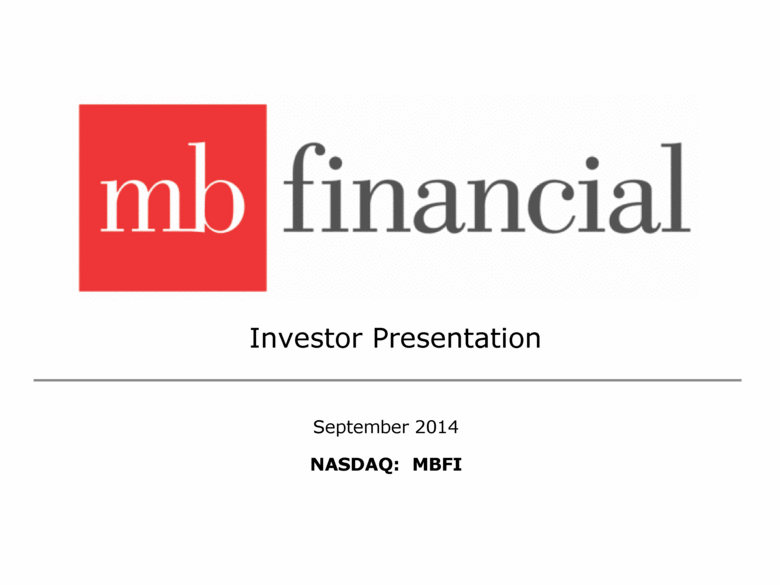
| September 2014 NASDAQ: MBFI Investor Presentation |
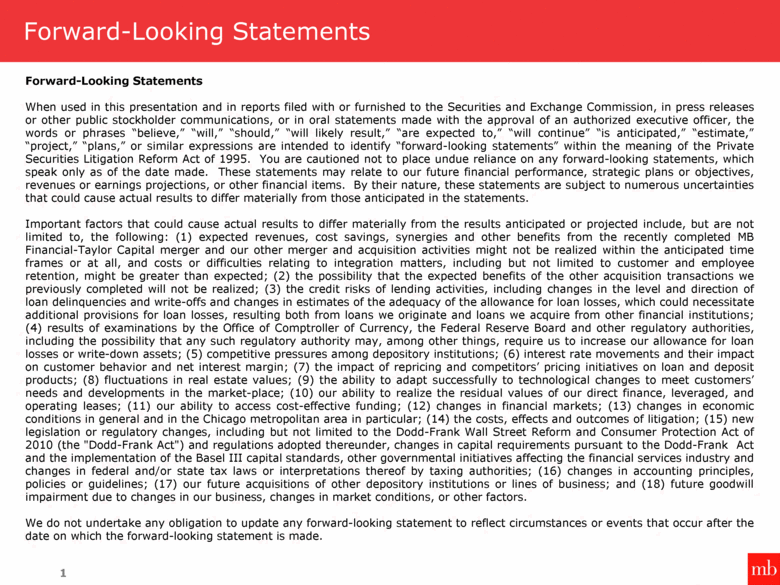
| Forward-Looking Statements 1 Forward-Looking Statements When used in this presentation and in reports filed with or furnished to the Securities and Exchange Commission, in press releases or other public stockholder communications, or in oral statements made with the approval of an authorized executive officer, the words or phrases “believe,” “will,” “should,” “will likely result,” “are expected to,” “will continue” “is anticipated,” “estimate,” “project,” “plans,” or similar expressions are intended to identify “forward-looking statements” within the meaning of the Private Securities Litigation Reform Act of 1995. You are cautioned not to place undue reliance on any forward-looking statements, which speak only as of the date made. These statements may relate to our future financial performance, strategic plans or objectives, revenues or earnings projections, or other financial items. By their nature, these statements are subject to numerous uncertainties that could cause actual results to differ materially from those anticipated in the statements. Important factors that could cause actual results to differ materially from the results anticipated or projected include, but are not limited to, the following: (1) expected revenues, cost savings, synergies and other benefits from the recently completed MB Financial-Taylor Capital merger and our other merger and acquisition activities might not be realized within the anticipated time frames or at all, and costs or difficulties relating to integration matters, including but not limited to customer and employee retention, might be greater than expected; (2) the possibility that the expected benefits of the other acquisition transactions we previously completed will not be realized; (3) the credit risks of lending activities, including changes in the level and direction of loan delinquencies and write-offs and changes in estimates of the adequacy of the allowance for loan losses, which could necessitate additional provisions for loan losses, resulting both from loans we originate and loans we acquire from other financial institutions; (4) results of examinations by the Office of Comptroller of Currency, the Federal Reserve Board and other regulatory authorities, including the possibility that any such regulatory authority may, among other things, require us to increase our allowance for loan losses or write-down assets; (5) competitive pressures among depository institutions; (6) interest rate movements and their impact on customer behavior and net interest margin; (7) the impact of repricing and competitors’ pricing initiatives on loan and deposit products; (8) fluctuations in real estate values; (9) the ability to adapt successfully to technological changes to meet customers’ needs and developments in the market-place; (10) our ability to realize the residual values of our direct finance, leveraged, and operating leases; (11) our ability to access cost-effective funding; (12) changes in financial markets; (13) changes in economic conditions in general and in the Chicago metropolitan area in particular; (14) the costs, effects and outcomes of litigation; (15) new legislation or regulatory changes, including but not limited to the Dodd-Frank Wall Street Reform and Consumer Protection Act of 2010 (the "Dodd-Frank Act") and regulations adopted thereunder, changes in capital requirements pursuant to the Dodd-Frank Act and the implementation of the Basel III capital standards, other governmental initiatives affecting the financial services industry and changes in federal and/or state tax laws or interpretations thereof by taxing authorities; (16) changes in accounting principles, policies or guidelines; (17) our future acquisitions of other depository institutions or lines of business; and (18) future goodwill impairment due to changes in our business, changes in market conditions, or other factors. We do not undertake any obligation to update any forward-looking statement to reflect circumstances or events that occur after the date on which the forward-looking statement is made. |
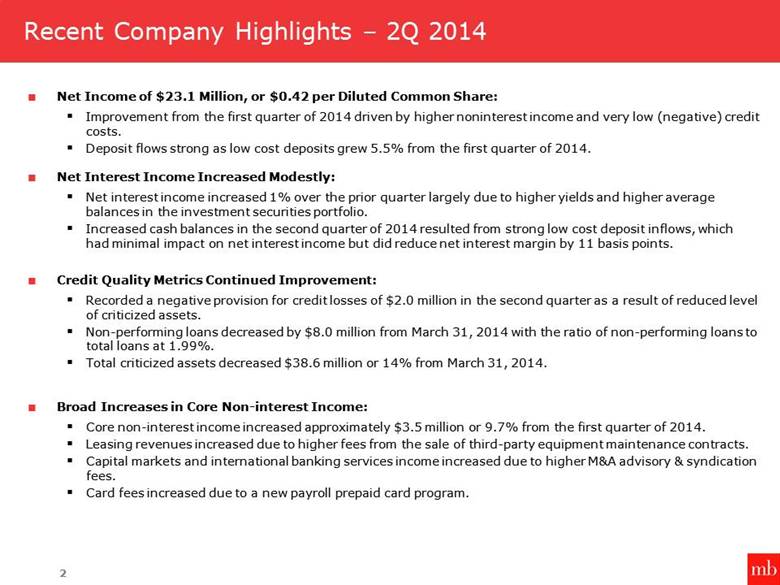
| Net Income of $23.1 Million, or $0.42 per Diluted Common Share: Improvement from the first quarter of 2014 driven by higher noninterest income and very low (negative) credit costs. Deposit flows strong as low cost deposits grew 5.5% from the first quarter of 2014. Net Interest Income Increased Modestly: Net interest income increased 1% over the prior quarter largely due to higher yields and higher average balances in the investment securities portfolio. Increased cash balances in the second quarter of 2014 resulted from strong low cost deposit inflows, which had minimal impact on net interest income but did reduce net interest margin by 11 basis points. Credit Quality Metrics Continued Improvement: Recorded a negative provision for credit losses of $2.0 million in the second quarter as a result of reduced level of criticized assets. Non-performing loans decreased by $8.0 million from March 31, 2014 with the ratio of non-performing loans to total loans at 1.99%. Total criticized assets decreased $38.6 million or 14% from March 31, 2014. Broad Increases in Core Non-interest Income: Core non-interest income increased approximately $3.5 million or 9.7% from the first quarter of 2014. Leasing revenues increased due to higher fees from the sale of third-party equipment maintenance contracts. Capital markets and international banking services income increased due to higher M&A advisory & syndication fees. Card fees increased due to a new payroll prepaid card program. Recent Company Highlights – 2Q 2014 2 |
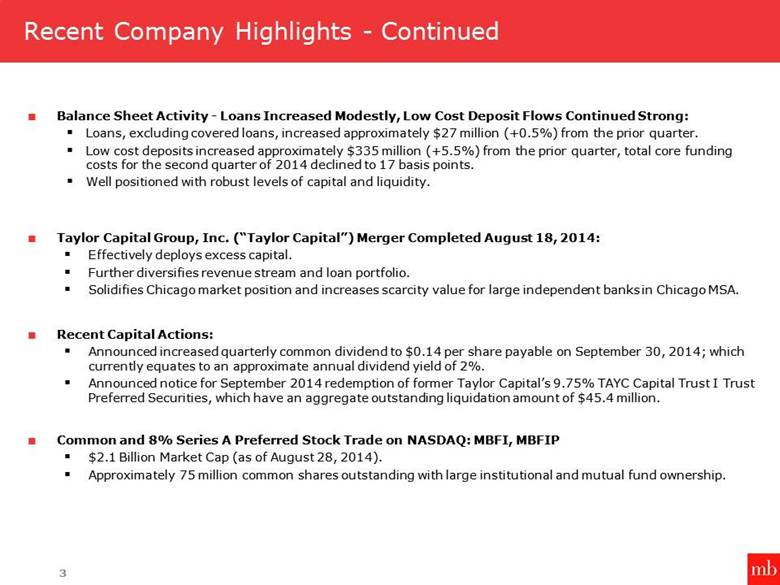
| Balance Sheet Activity - Loans Increased Modestly, Low Cost Deposit Flows Continued Strong: Loans, excluding covered loans, increased approximately $27 million (+0.5%) from the prior quarter. Low cost deposits increased approximately $335 million (+5.5%) from the prior quarter, total core funding costs for the second quarter of 2014 declined to 17 basis points. Well positioned with robust levels of capital and liquidity. Taylor Capital Group, Inc. (“Taylor Capital”) Merger Completed August 18, 2014: Effectively deploys excess capital. Further diversifies revenue stream and loan portfolio. Solidifies Chicago market position and increases scarcity value for large independent banks in Chicago MSA. Recent Capital Actions: Announced increased quarterly common dividend to $0.14 per share payable on September 30, 2014; which currently equates to an approximate annual dividend yield of 2%. Announced notice for September 2014 redemption of former Taylor Capital’s 9.75% TAYC Capital Trust I Trust Preferred Securities, which have an aggregate outstanding liquidation amount of $45.4 million. Common and 8% Series A Preferred Stock Trade on NASDAQ: MBFI, MBFIP $2.1 Billion Market Cap (as of August 28, 2014). Approximately 75 million common shares outstanding with large institutional and mutual fund ownership. Recent Company Highlights - Continued 3 |
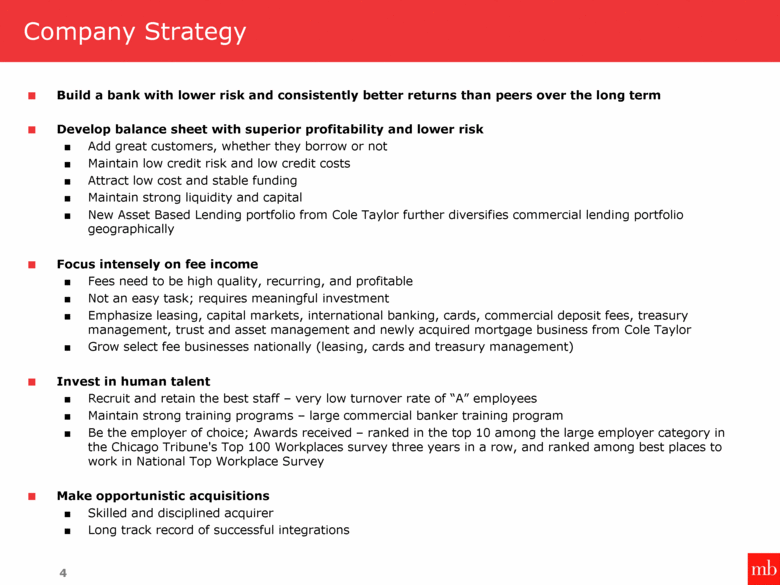
| Company Strategy Build a bank with lower risk and consistently better returns than peers over the long term Develop balance sheet with superior profitability and lower risk Add great customers, whether they borrow or not Maintain low credit risk and low credit costs Attract low cost and stable funding Maintain strong liquidity and capital New Asset Based Lending portfolio from Cole Taylor further diversifies commercial lending portfolio geographically Focus intensely on fee income Fees need to be high quality, recurring, and profitable Not an easy task; requires meaningful investment Emphasize leasing, capital markets, international banking, cards, commercial deposit fees, treasury management, trust and asset management and newly acquired mortgage business from Cole Taylor Grow select fee businesses nationally (leasing, cards and treasury management) Invest in human talent Recruit and retain the best staff – very low turnover rate of “A” employees Maintain strong training programs – large commercial banker training program Be the employer of choice; Awards received – ranked in the top 10 among the large employer category in the Chicago Tribune's Top 100 Workplaces survey three years in a row, and ranked among best places to work in National Top Workplace Survey Make opportunistic acquisitions Skilled and disciplined acquirer Long track record of successful integrations 4 |
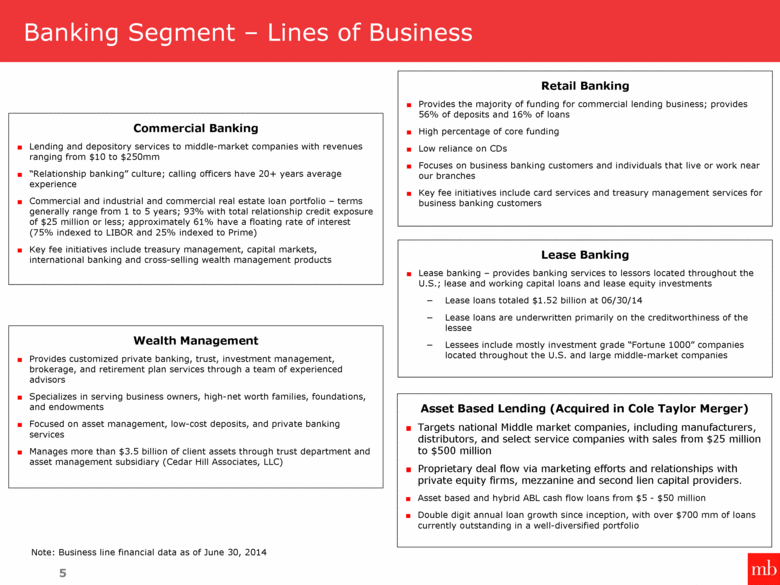
| Banking Segment – Lines of Business 5 Retail Banking Provides the majority of funding for commercial lending business; provides 56% of deposits and 16% of loans High percentage of core funding Low reliance on CDs Focuses on business banking customers and individuals that live or work near our branches Key fee initiatives include card services and treasury management services for business banking customers Wealth Management Provides customized private banking, trust, investment management, brokerage, and retirement plan services through a team of experienced advisors Specializes in serving business owners, high-net worth families, foundations, and endowments Focused on asset management, low-cost deposits, and private banking services Manages more than $3.5 billion of client assets through trust department and asset management subsidiary (Cedar Hill Associates, LLC) Commercial Banking Lending and depository services to middle-market companies with revenues ranging from $10 to $250mm “Relationship banking” culture; calling officers have 20+ years average experience Commercial and industrial and commercial real estate loan portfolio – terms generally range from 1 to 5 years; 93% with total relationship credit exposure of $25 million or less; approximately 61% have a floating rate of interest (75% indexed to LIBOR and 25% indexed to Prime) Key fee initiatives include treasury management, capital markets, international banking and cross-selling wealth management products Note: Business line financial data as of June 30, 2014 Lease Banking Lease banking – provides banking services to lessors located throughout the U.S.; lease and working capital loans and lease equity investments Lease loans totaled $1.52 billion at 06/30/14 Lease loans are underwritten primarily on the creditworthiness of the lessee Lessees include mostly investment grade “Fortune 1000” companies located throughout the U.S. and large middle-market companies Asset Based Lending (Acquired in Cole Taylor Merger) Targets national Middle market companies, including manufacturers, distributors, and select service companies with sales from $25 million to $500 million Proprietary deal flow via marketing efforts and relationships with private equity firms, mezzanine and second lien capital providers. Asset based and hybrid ABL cash flow loans from $5 - $50 million Double digit annual loan growth since inception, with over $700 mm of loans currently outstanding in a well-diversified portfolio |
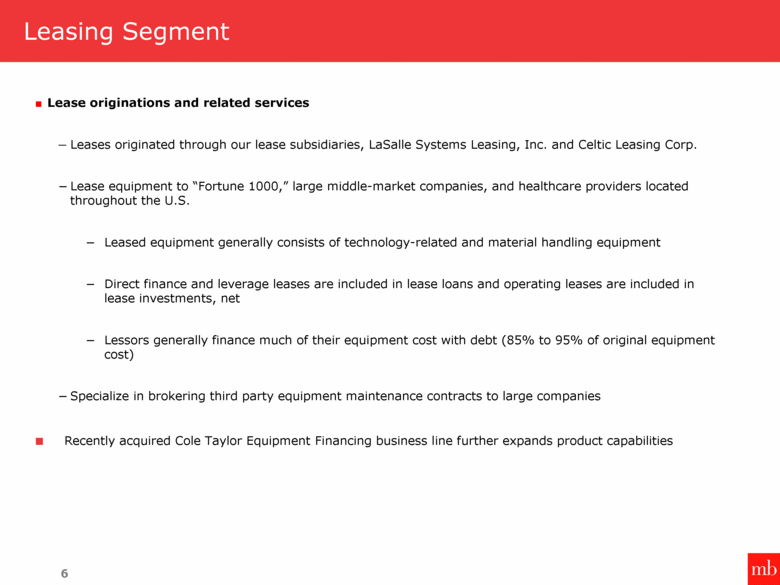
| Leasing Segment Lease originations and related services Leases originated through our lease subsidiaries, LaSalle Systems Leasing, Inc. and Celtic Leasing Corp. Lease equipment to “Fortune 1000,” large middle-market companies, and healthcare providers located throughout the U.S. Leased equipment generally consists of technology-related and material handling equipment Direct finance and leverage leases are included in lease loans and operating leases are included in lease investments, net Lessors generally finance much of their equipment cost with debt (85% to 95% of original equipment cost) Specialize in brokering third party equipment maintenance contracts to large companies Recently acquired Cole Taylor Equipment Financing business line further expands product capabilities 6 |
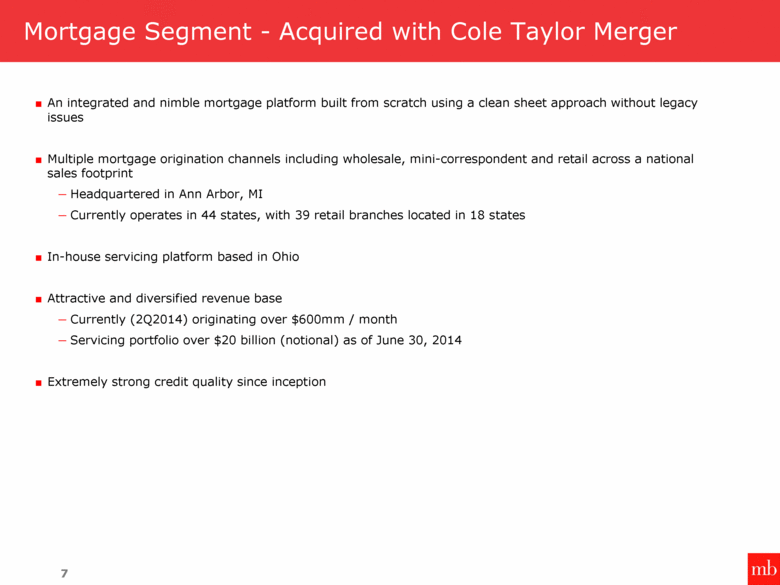
| Mortgage Segment - Acquired with Cole Taylor Merger An integrated and nimble mortgage platform built from scratch using a clean sheet approach without legacy issues Multiple mortgage origination channels including wholesale, mini-correspondent and retail across a national sales footprint Headquartered in Ann Arbor, MI Currently operates in 44 states, with 39 retail branches located in 18 states In-house servicing platform based in Ohio Attractive and diversified revenue base Currently (2Q2014) originating over $600mm / month Servicing portfolio over $20 billion (notional) as of June 30, 2014 Extremely strong credit quality since inception 7 |
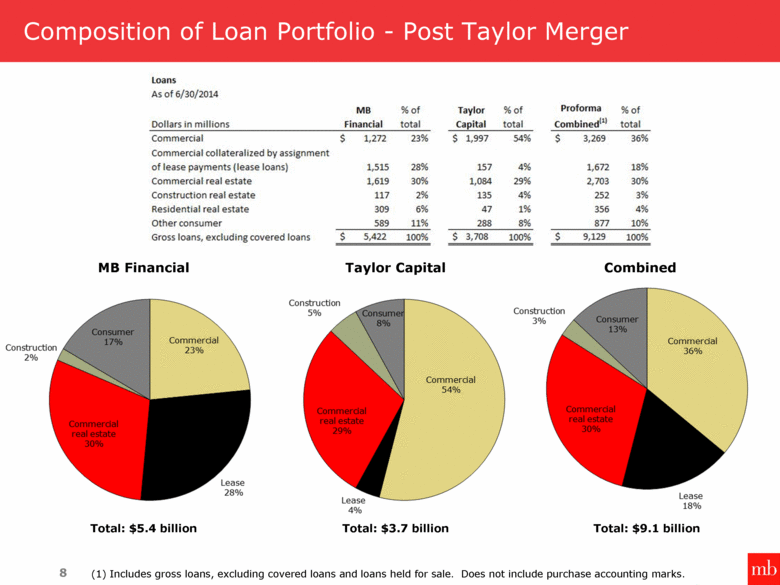
| Composition of Loan Portfolio - Post Taylor Merger 8 (1) Includes gross loans, excluding covered loans and loans held for sale. Does not include purchase accounting marks. MB Financial Taylor Capital Combined Total: $5.4 billion Total: $3.7 billion Total: $9.1 billion |
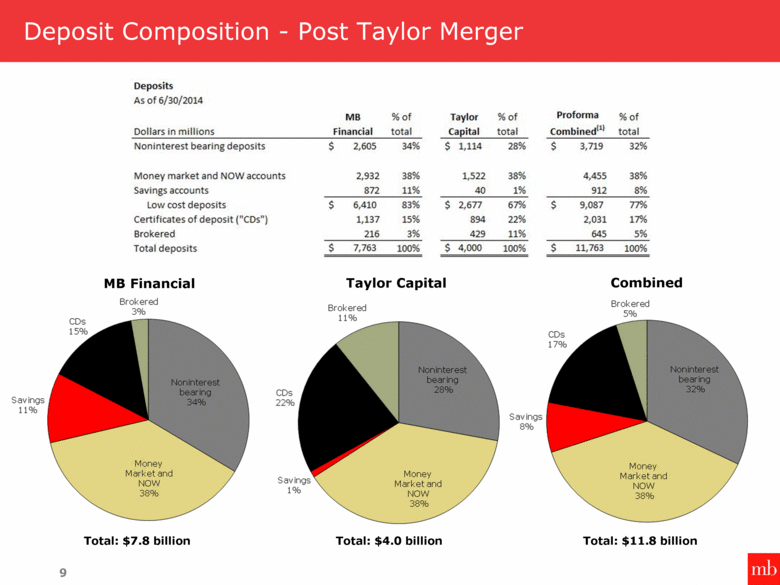
| Deposit Composition - Post Taylor Merger 9 MB Financial Taylor Capital Combined Total: $7.8 billion Total: $4.0 billion Total: $11.8 billion |
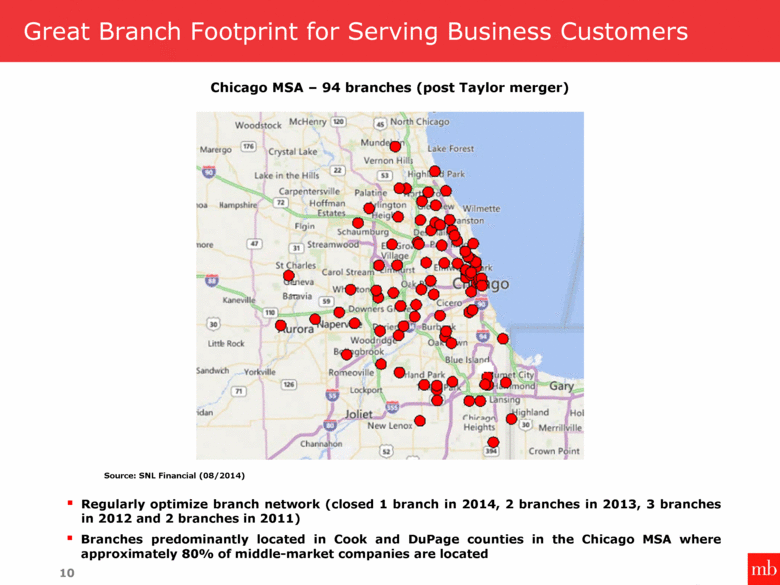
| Great Branch Footprint for Serving Business Customers 10 Chicago MSA – 94 branches (post Taylor merger) Regularly optimize branch network (closed 1 branch in 2014, 2 branches in 2013, 3 branches in 2012 and 2 branches in 2011) Branches predominantly located in Cook and DuPage counties in the Chicago MSA where approximately 80% of middle-market companies are located Source: SNL Financial (08/2014) |
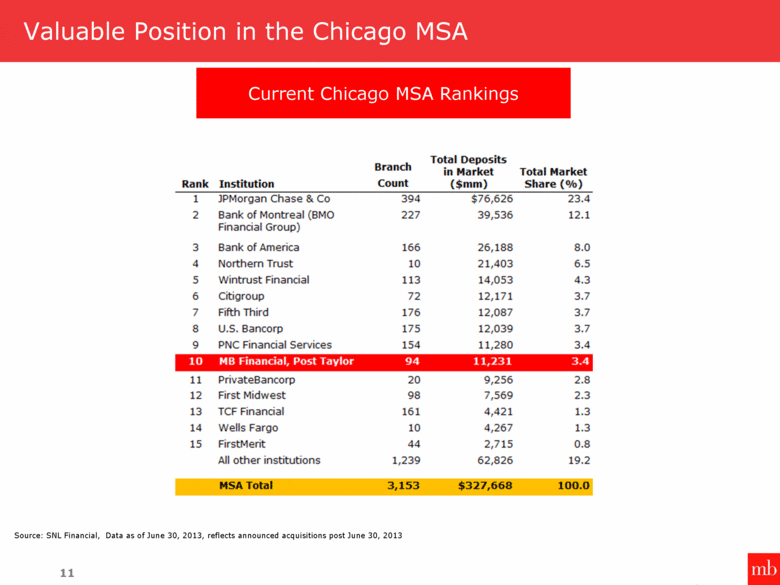
| Valuable Position in the Chicago MSA Current Chicago MSA Rankings Source: SNL Financial, Data as of June 30, 2013, reflects announced acquisitions post June 30, 2013 11 |
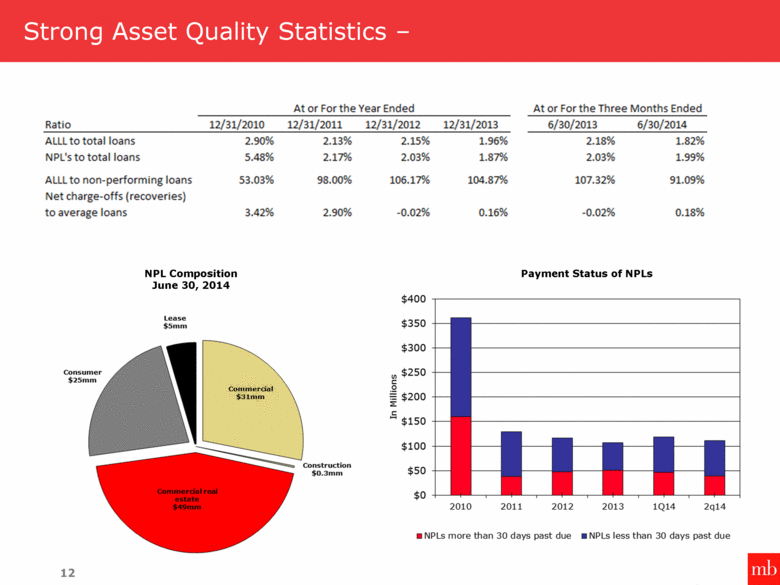
| NPL Composition June 30, 2014 Strong Asset Quality Statistics – 12 Payment Status of NPLs |
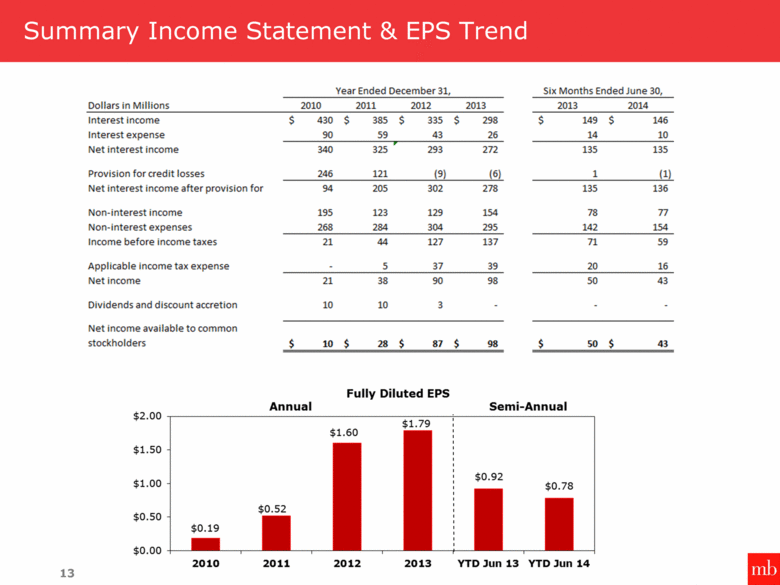
| Summary Income Statement & EPS Trend 13 |
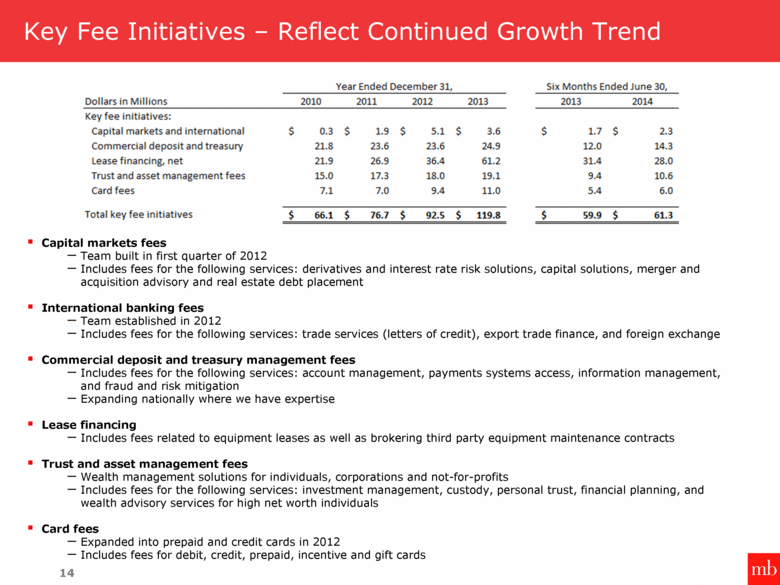
| Key Fee Initiatives – Reflect Continued Growth Trend 14 Capital markets fees Team built in first quarter of 2012 Includes fees for the following services: derivatives and interest rate risk solutions, capital solutions, merger and acquisition advisory and real estate debt placement International banking fees Team established in 2012 Includes fees for the following services: trade services (letters of credit), export trade finance, and foreign exchange Commercial deposit and treasury management fees Includes fees for the following services: account management, payments systems access, information management, and fraud and risk mitigation Expanding nationally where we have expertise Lease financing Includes fees related to equipment leases as well as brokering third party equipment maintenance contracts Trust and asset management fees Wealth management solutions for individuals, corporations and not-for-profits Includes fees for the following services: investment management, custody, personal trust, financial planning, and wealth advisory services for high net worth individuals Card fees Expanded into prepaid and credit cards in 2012 Includes fees for debit, credit, prepaid, incentive and gift cards |
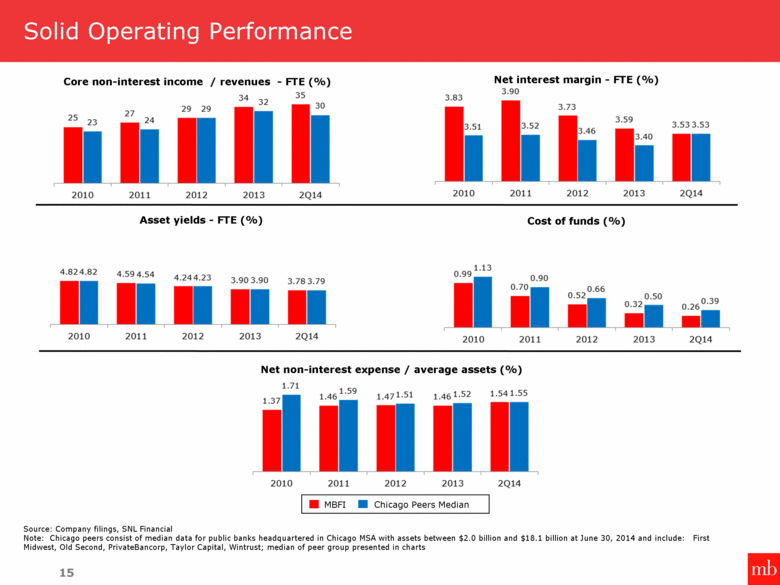
| Solid Operating Performance 15 Net non-interest expense / average assets (%) Asset yields - FTE (%) Cost of funds (%) MBFI Chicago Peers Median Net interest margin - FTE (%) Core non-interest income / revenues - FTE (%) Source: Company filings, SNL Financial Note: Chicago peers consist of median data for public banks headquartered in Chicago MSA with assets between $2.0 billion and $18.1 billion at June 30, 2014 and include: First Midwest, Old Second, PrivateBancorp, Taylor Capital, Wintrust; median of peer group presented in charts |
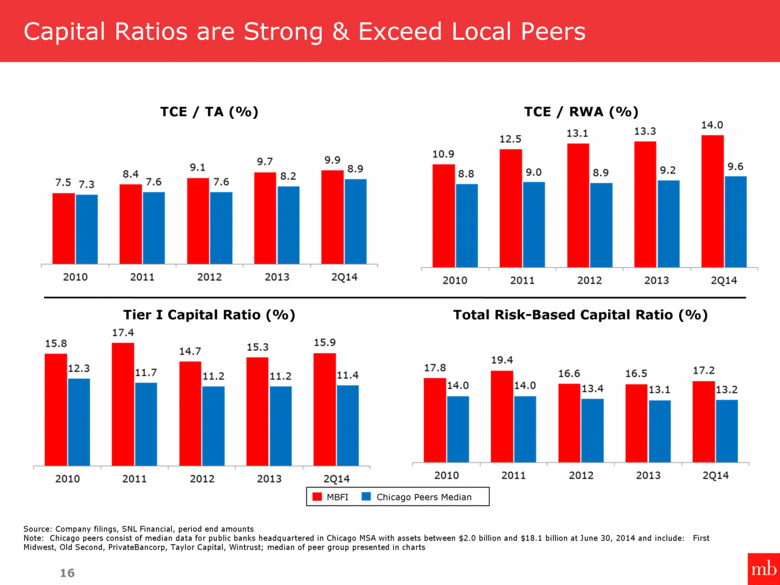
| Capital Ratios are Strong & Exceed Local Peers 16 TCE / TA (%) Tier I Capital Ratio (%) Total Risk-Based Capital Ratio (%) TCE / RWA (%) MBFI Chicago Peers Median Source: Company filings, SNL Financial, period end amounts Note: Chicago peers consist of median data for public banks headquartered in Chicago MSA with assets between $2.0 billion and $18.1 billion at June 30, 2014 and include: First Midwest, Old Second, PrivateBancorp, Taylor Capital, Wintrust; median of peer group presented in charts |
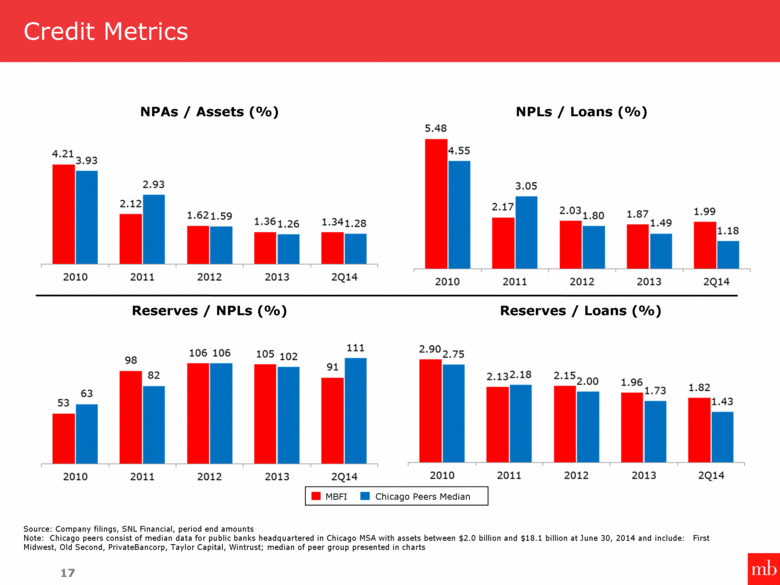
| 17 Source: Company filings, SNL Financial, period end amounts Note: Chicago peers consist of median data for public banks headquartered in Chicago MSA with assets between $2.0 billion and $18.1 billion at June 30, 2014 and include: First Midwest, Old Second, PrivateBancorp, Taylor Capital, Wintrust; median of peer group presented in charts NPAs / Assets (%) Reserves/Loans (%) Reserves / NPLs (%) Credit Metrics Reserves / Loans (%) NPLs / Loans (%) MBFI Chicago Peers Median |
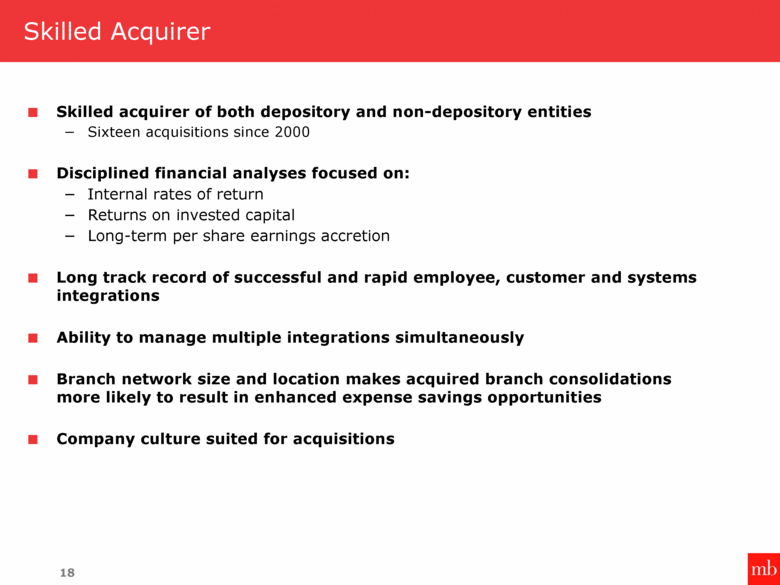
| 18 Skilled Acquirer Skilled acquirer of both depository and non-depository entities Sixteen acquisitions since 2000 Disciplined financial analyses focused on: Internal rates of return Returns on invested capital Long-term per share earnings accretion Long track record of successful and rapid employee, customer and systems integrations Ability to manage multiple integrations simultaneously Branch network size and location makes acquired branch consolidations more likely to result in enhanced expense savings opportunities Company culture suited for acquisitions |
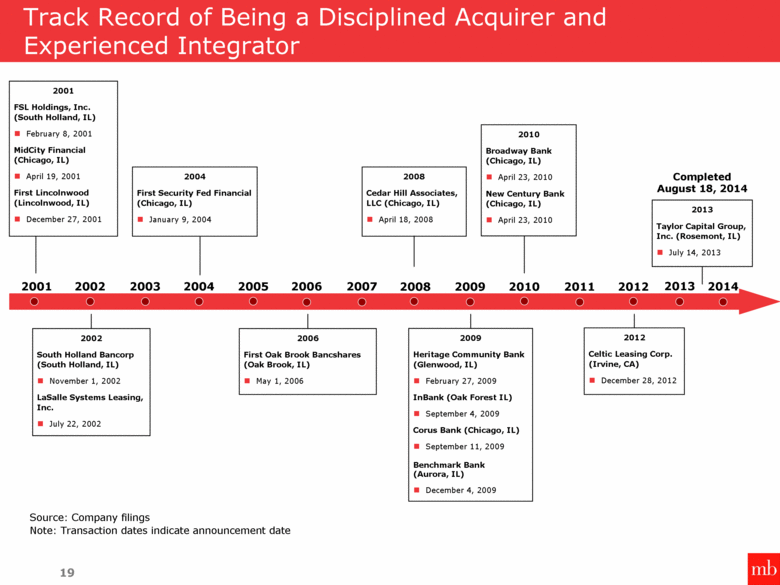
| 19 2001 2002 2004 2006 2008 2004 First Security Fed Financial (Chicago, IL) January 9, 2004 2002 South Holland Bancorp (South Holland, IL) November 1, 2002 LaSalle Systems Leasing, Inc. July 22, 2002 2006 First Oak Brook Bancshares (Oak Brook, IL) May 1, 2006 2009 Heritage Community Bank (Glenwood, IL) February 27, 2009 InBank (Oak Forest IL) September 4, 2009 Corus Bank (Chicago, IL) September 11, 2009 Benchmark Bank (Aurora, IL) December 4, 2009 Source: Company filings Note: Transaction dates indicate announcement date 2008 Cedar Hill Associates, LLC (Chicago, IL) April 18, 2008 Track Record of Being a Disciplined Acquirer and Experienced Integrator 2009 2010 2010 Broadway Bank (Chicago, IL) April 23, 2010 New Century Bank (Chicago, IL) April 23, 2010 2001 FSL Holdings, Inc. (South Holland, IL) February 8, 2001 MidCity Financial (Chicago, IL) April 19, 2001 First Lincolnwood (Lincolnwood, IL) December 27, 2001 2012 2012 Celtic Leasing Corp. (Irvine, CA) December 28, 2012 2003 2005 2007 2011 2013 2013 Taylor Capital Group, Inc. (Rosemont, IL) July 14, 2013 2014 Completed August 18, 2014 |
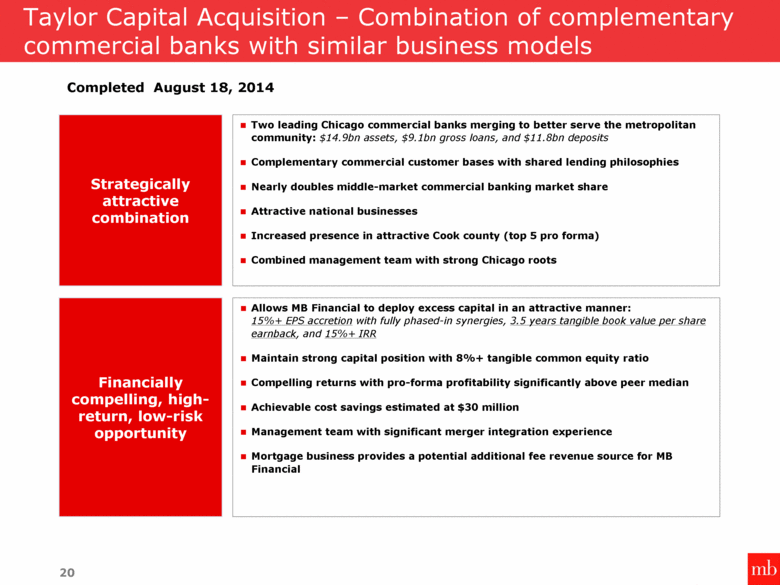
| Taylor Capital Acquisition – Combination of complementary commercial banks with similar business models Strategically attractive combination Financially compelling, high-return, low-risk opportunity Two leading Chicago commercial banks merging to better serve the metropolitan community: $14.9bn assets, $9.1bn gross loans, and $11.8bn deposits Complementary commercial customer bases with shared lending philosophies Nearly doubles middle-market commercial banking market share Attractive national businesses Increased presence in attractive Cook county (top 5 pro forma) Combined management team with strong Chicago roots Allows MB Financial to deploy excess capital in an attractive manner: 15%+ EPS accretion with fully phased-in synergies, 3.5 years tangible book value per share earnback, and 15%+ IRR Maintain strong capital position with 8%+ tangible common equity ratio Compelling returns with pro-forma profitability significantly above peer median Achievable cost savings estimated at $30 million Management team with significant merger integration experience Mortgage business provides a potential additional fee revenue source for MB Financial 20 Completed August 18, 2014 |
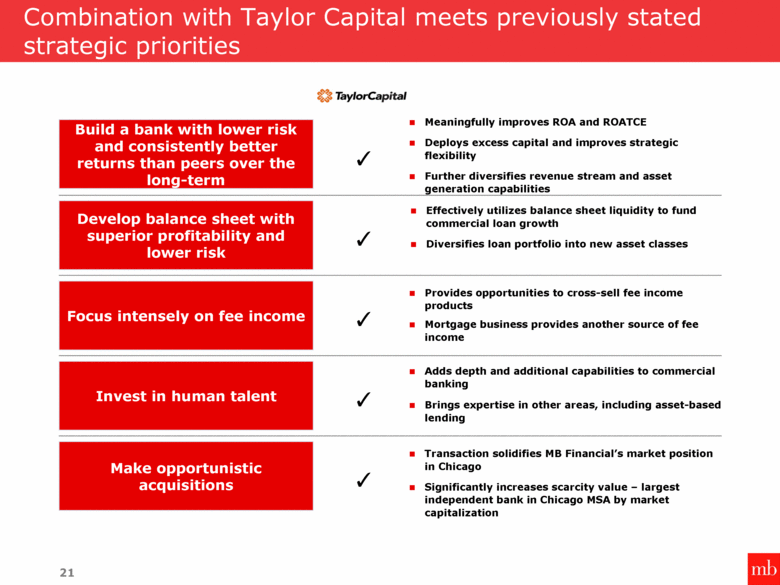
| Combination with Taylor Capital meets previously stated strategic priorities ✓ ✓ ✓ ✓ ✓ Build a bank with lower risk and consistently better returns than peers over the long-term Develop balance sheet with superior profitability and lower risk Focus intensely on fee income Invest in human talent Make opportunistic acquisitions Meaningfully improves ROA and ROATCE Deploys excess capital and improves strategic flexibility Further diversifies revenue stream and asset generation capabilities Effectively utilizes balance sheet liquidity to fund commercial loan growth Diversifies loan portfolio into new asset classes Provides opportunities to cross-sell fee income products Mortgage business provides another source of fee income Adds depth and additional capabilities to commercial banking Brings expertise in other areas, including asset-based lending Transaction solidifies MB Financial’s market position in Chicago Significantly increases scarcity value – largest independent bank in Chicago MSA by market capitalization 21 |
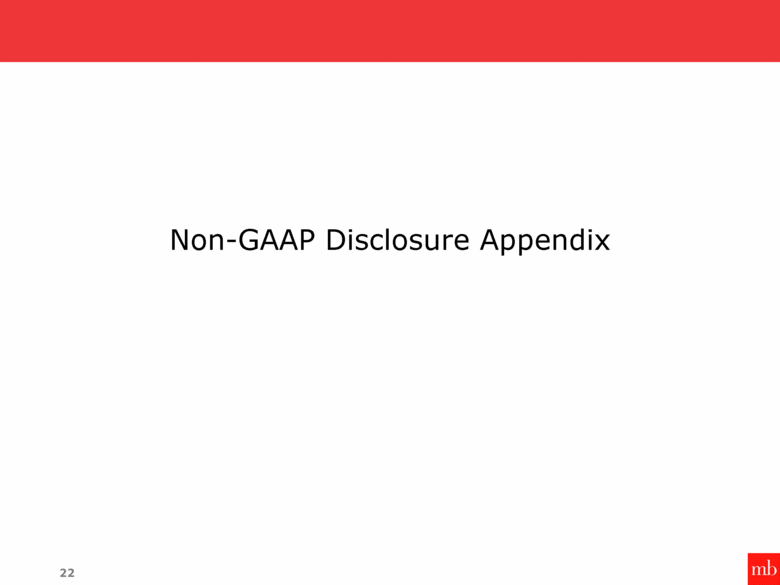
| Non-GAAP Disclosure Appendix 22 |
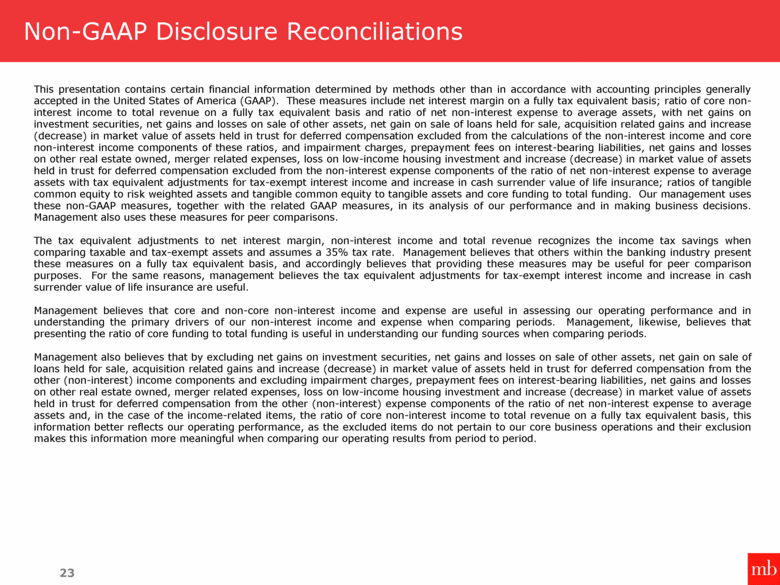
| Non-GAAP Disclosure Reconciliations This presentation contains certain financial information determined by methods other than in accordance with accounting principles generally accepted in the United States of America (GAAP). These measures include net interest margin on a fully tax equivalent basis; ratio of core non-interest income to total revenue on a fully tax equivalent basis and ratio of net non-interest expense to average assets, with net gains on investment securities, net gains and losses on sale of other assets, net gain on sale of loans held for sale, acquisition related gains and increase (decrease) in market value of assets held in trust for deferred compensation excluded from the calculations of the non-interest income and core non-interest income components of these ratios, and impairment charges, prepayment fees on interest-bearing liabilities, net gains and losses on other real estate owned, merger related expenses, loss on low-income housing investment and increase (decrease) in market value of assets held in trust for deferred compensation excluded from the non-interest expense components of the ratio of net non-interest expense to average assets with tax equivalent adjustments for tax-exempt interest income and increase in cash surrender value of life insurance; ratios of tangible common equity to risk weighted assets and tangible common equity to tangible assets and core funding to total funding. Our management uses these non-GAAP measures, together with the related GAAP measures, in its analysis of our performance and in making business decisions. Management also uses these measures for peer comparisons. The tax equivalent adjustments to net interest margin, non-interest income and total revenue recognizes the income tax savings when comparing taxable and tax-exempt assets and assumes a 35% tax rate. Management believes that others within the banking industry present these measures on a fully tax equivalent basis, and accordingly believes that providing these measures may be useful for peer comparison purposes. For the same reasons, management believes the tax equivalent adjustments for tax-exempt interest income and increase in cash surrender value of life insurance are useful. Management believes that core and non-core non-interest income and expense are useful in assessing our operating performance and in understanding the primary drivers of our non-interest income and expense when comparing periods. Management, likewise, believes that presenting the ratio of core funding to total funding is useful in understanding our funding sources when comparing periods. Management also believes that by excluding net gains on investment securities, net gains and losses on sale of other assets, net gain on sale of loans held for sale, acquisition related gains and increase (decrease) in market value of assets held in trust for deferred compensation from the other (non-interest) income components and excluding impairment charges, prepayment fees on interest-bearing liabilities, net gains and losses on other real estate owned, merger related expenses, loss on low-income housing investment and increase (decrease) in market value of assets held in trust for deferred compensation from the other (non-interest) expense components of the ratio of net non-interest expense to average assets and, in the case of the income-related items, the ratio of core non-interest income to total revenue on a fully tax equivalent basis, this information better reflects our operating performance, as the excluded items do not pertain to our core business operations and their exclusion makes this information more meaningful when comparing our operating results from period to period. 23 |
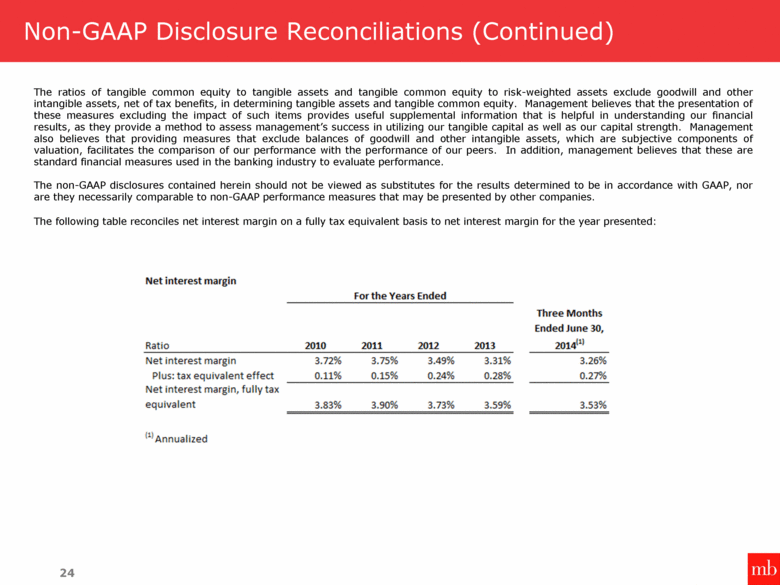
| Non-GAAP Disclosure Reconciliations (Continued) The ratios of tangible common equity to tangible assets and tangible common equity to risk-weighted assets exclude goodwill and other intangible assets, net of tax benefits, in determining tangible assets and tangible common equity. Management believes that the presentation of these measures excluding the impact of such items provides useful supplemental information that is helpful in understanding our financial results, as they provide a method to assess management’s success in utilizing our tangible capital as well as our capital strength. Management also believes that providing measures that exclude balances of goodwill and other intangible assets, which are subjective components of valuation, facilitates the comparison of our performance with the performance of our peers. In addition, management believes that these are standard financial measures used in the banking industry to evaluate performance. The non-GAAP disclosures contained herein should not be viewed as substitutes for the results determined to be in accordance with GAAP, nor are they necessarily comparable to non-GAAP performance measures that may be presented by other companies. The following table reconciles net interest margin on a fully tax equivalent basis to net interest margin for the year presented: 24 |
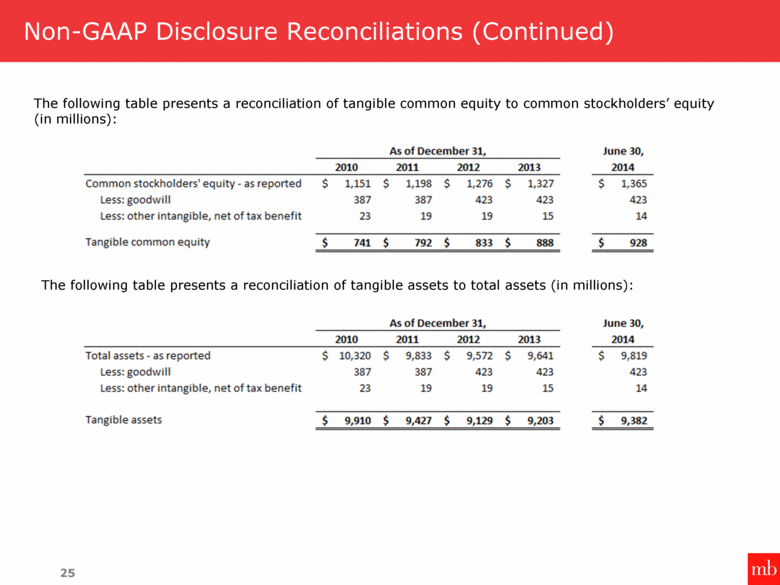
| Non-GAAP Disclosure Reconciliations (Continued) The following table presents a reconciliation of tangible common equity to common stockholders’ equity (in millions): 25 The following table presents a reconciliation of tangible assets to total assets (in millions): |
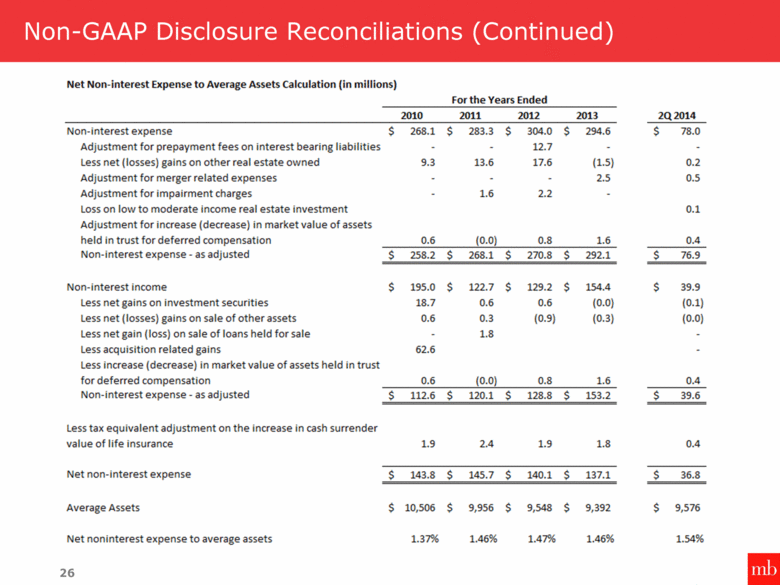
| Non-GAAP Disclosure Reconciliations (Continued) 26 |
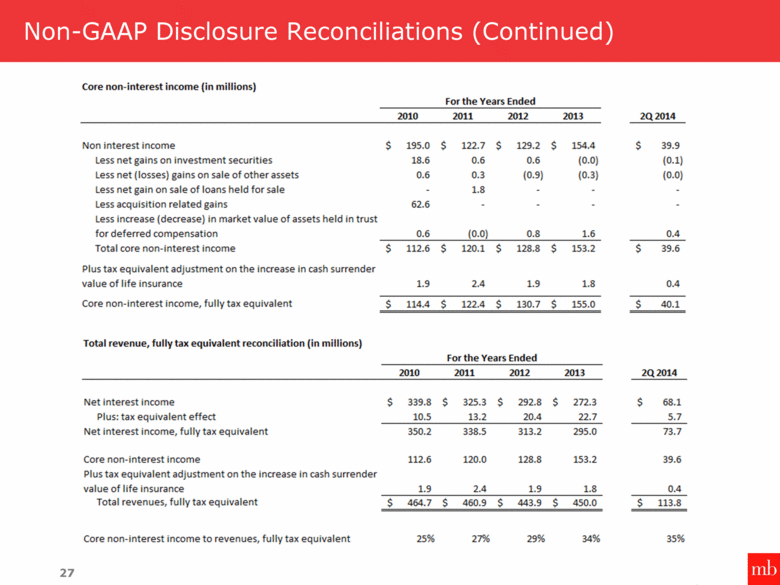
| Non-GAAP Disclosure Reconciliations (Continued) 27 |

| September 2014 NASDAQ: MBFI Investor Presentation |
SIGNATURES
Pursuant to the requirements of the Securities Exchange Act of 1934, the registrant has duly caused this report to be signed on its behalf by the undersigned hereunto duly authorized.
| MB FINANCIAL, INC. |
| |
Date: September 2, 2014 | By: | /s/Jill E. York |
| | Jill E. York |
| | Vice President and Chief Financial Officer |
29



























